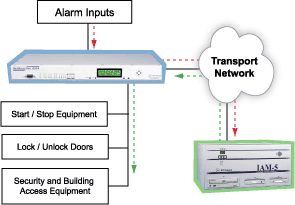Check out our White Paper Series!
A complete library of helpful advice and survival guides for every aspect of system monitoring and control.
1-800-693-0351
Have a specific question? Ask our team of expert engineers and get a specific answer!
Sign up for the next DPS Factory Training!

Whether you're new to our equipment or you've used it for years, DPS factory training is the best way to get more from your monitoring.
Reserve Your Seat Today
One of the things I hear a lot from clients is that they're looking for a network monitoring solution that meets all their needs. Not just some of their needs, and not just meeting them part way.
In this issue of QuickTips, you'll read about Glenn Lippincott of the Southern Company, who had a problem with unreliable legacy equipment, and how we helped him find the perfect fit solution that made his network monitoring more reliable and avoided a costly forklift swap-out of his legacy remotes.
We can meet your needs like no other vendor because of our successful strategy of vertical integration. From the initial design to the finished product, we are responsible for every part of our network monitoring systems. We can rapidly create prototypes to meet your specifications, test them under real-world conditions, and produce a final product that will do exactly what you want to do.
Best of all, our custom engineering services are available at absolutely no risk to you. Just for a minimum order, we assume the costs of all design work. If you are not completely satisfied with your custom solution for any reason, you don't have to pay for it, guaranteed.
So if you're feeling that your network monitoring is exactly what you want it to be, talk to a DPS Telecom Applications Engineer at 1-800-693-0351. We're ready to help you get the network monitoring reliability you've always wanted.
Sincerely,
Ron Stover,
DPS Telecom Technical Support
How a Simple Tech Support Call Saved Hundreds of Thousands of Dollars
"DPS told us we didn't have to pay if it didn't work. It works and it's sweet." - Glenn Lippincott, Southern Company
When Glenn Lippincott of Southern Company called DPS Telecom tech support, he wasn't planning on replacing his legacy Badger remotes with a new, custom-engineered network monitoring solution. He thought he had a simple question about his T/MonXM system. But as tech support chief Ron Stover walked him through his T/MonXM configuration, Lippincott saw a menu item that caught his eye. So he asked about it, and the answer helped him improve his network monitoring and save his company hundreds of thousands of dollars.
Most remote telemetry units offer only limited functions for detecting LAN connectivity. A standard remote can only detect whether its local connection is up. If the local connection is intact, but the LAN beyond the connection is down, the basic remote will still report a working LAN. Compare this to the NetGuardian, whose ability to ping any selected IP address gives it visibility of the complete alarm reporting path.
One of the great things about the NetGuardian is that it's a LAN-based remote that's still operational when the LAN is down. Because of its internal modem and paging capability, the NetGuardian always has an alternate path for sending alarm data or page notifications even if your entire LAN fails.

This means that the NetGuardian can effectively monitor its own LAN connection. Many users have configured their NetGuardians to send a pager notification if the LAN connection fails. (Pager notifications can also be used to provide continued visibility of other critical alarms during a LAN failure.)
To illustrate the NetGuardian ping functionality, let's look at a call from a client who wasn't getting notification of LAN failures because it wasn't the local connection path that was failing.
How to detect the true state of the LAN connection ...
Try the Alarm Collection Devices Knowledge Base
We've just updated our Applications Knowledge Base to include a full guide to selecting the capabilities you require in an Alarm Collection Device that will best protect your network. The Alarm Collection Devices Knowledge Base will guide you step-by-step - from identifying your monitoring goals, to the applications that will meet your goals, to the actual products you need to make those applications work, to achieving increased network reliability.
Four Derived Alarm Applications You Aren't Using, But Should
Derived alarms and controls are one of the most powerful features in T/MonXM. Derived alarms are "virtual" alarms created through user-defined formulas that coordinate inputs from several alarm points and apply logical operators to them. One classic example of a derived alarm is the combination of a low battery AND a broken generator. Either condition isn't only a Major alarm by itself; but in combination, they are a Critical alarm.

The value of derived alarms is that they provide a way for you to watch for alarm combination scenarios. You don't have to scan your monitoring screens to figure out what's happening with your network. If you've configured your derived alarms, you've told T/MonXM what to watch for, and it will keep track of your alarms for you.
Notification when scheduled events do not happen when they should.
Notification of events that are only alarms when they happen at a certain time.
What can go undetected without derived alarms ...
How to Create A Derived Alarm for an Event That Doesn't Happen
An interesting and useful application of derived alarms is creating alarm formulas that alert you when events do not happen. These alarms can inform you of failures where equipment should start and run automatically but does not, or if any other scheduled event that you want to know when it doesn't happen.
This is particularly useful for maintaining visibility of recurrent background events, such as periodic equipment tests. A weekly alarm informing system operators that all is well is a nuisance alarm that will be ignored, and no one will notice when the alarm doesn't happen. A negative derived alarm will instead inform system operators only when the equipment test fails to occur as scheduled.
How to create a derived alarm for non-events ...
Are you still running an older version of T/MonXM? The new T/MonXM 4.2 includes over 50 separate improvements, including new capabilities and time-saving user features. Software upgrades are free to T/Mon Gold Plan subscribers, just one of the many benefits of the T/Mon Gold Plan.
DPS Telecom will be hosting factory training classes at its headquarters in Fresno, California, October 27-30. The classes will cover all aspects of installing and operating the T/MonXM Network Alarm Management System, the NetGuardian, ASCII alarm processing, the new Remote Alarm Block 176, and more ...

All classes will be taught by DPS Telecom technical support expert Johnny Maldonado. Johnny has performed over 100 onsite installations in the United States and abroad and has taught over 30 training classes. Johnny's hands-on approach to teaching has given his many students a more meaningful understanding of the setup and operation of DPS Telecom equipment.
Call 1-800-693-0351 today to reserve a place for this valuable instruction. Come and see why Johnny's students say "This class will make your job easier!"